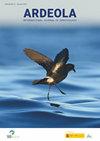碳δ13C同位素标记值与成年黄腿鸥喙部类胡萝卜素着色的相关性
IF 1.2
4区 生物学
Q2 ORNITHOLOGY
引用次数: 0
摘要
总结。由于类胡萝卜素必须通过饮食获得,因此许多鸟类呈现的类胡萝卜素色素可能真实地反映了携带者的质量。这些色素对许多生理功能都很重要,个体可以在这些用途的类胡萝卜素分配与第二性和社会特征的类胡萝卜素积累之间找到权衡。黄腿鸥是一种机会主义的物种,以各种各样的猎物为食。我们研究了以类胡萝卜素为基础的着色(喙、红点、眼环)是否与该物种3个种群成年羽毛的同位素组成推断的营养生态学有关。同位素标记δ13C与类胡萝卜素着色(红斑区)呈负相关。与先验预测相反,该标记表明,对垃圾填埋场垃圾和陆地猎物的较高消耗可能导致成年黄腿鸥的红喙斑点较大,与性别无关。未发现同位素特征与雌性卵子体积之间的相关性。食用更多的海洋猎物可能意味着红点更小,这一发现支持了其他鸟类研究的一些结果,这些研究报告称,食用与人类有关的陆地食物来源对成年鸟类的表型有明显的积极影响。结果可能表明,更多的海洋猎物的消耗可能不像以前的研究所支持的那样有利。尽管如此,应该进一步研究可能来自某些喂养来源的潜在有毒化合物的影响,包括对成年鸡(可能还有雏鸡)生理上的任何延迟的亚致死效应。-Zorrozua, N., Alonso-Álvarez, C., Diaz, B., Sanpera, C., Jover, Ll.& Arizaga, J.(2020)。碳δ13C同位素标记值与成年黄腿鸥喙部类胡萝卜素着色相关。中国生物医学工程学报,32(6):325-339。本文章由计算机程序翻译,如有差异,请以英文原文为准。
Carbon δ13C Isotopic Marker Values Correlate with Carotenoid-Based Bill Colouration in Adult Yellow-Legged Gulls Larus michahellis
Summary. The carotenoid-based colouration that many birds present may honestly reflect the quality of the bearer, as carotenoids have to be obtained through diet. These pigments are important for many physiological functions and individuals could find a trade-off between the allocation of carotenoids for these uses and their accumulation for secondary-sexual and social traits. The Yellow-legged Gull Larus michahellis is an opportunistic species that feeds on a wide spectrum of prey. We studied whether carotenoid-based colouration (bill, red spot, eye-ring) is related to the trophic ecology inferred by the isotopic composition of adults' feathers at three colonies of this species. The isotopic marker δ13C negatively correlated with carotenoid-based colouration (red spot area). Contrarily to a priori prediction, the marker indicated that higher consumption of landfill scraps and terrestrial prey might lead to a larger red bill spot in adult Yellow-legged Gulls independently of sex. No correlation was detected between isotopic signatures and egg volume in females. The finding that higher consumption of marine prey may imply a smaller red spot supports some results from other avian studies that report that feeding on human-related terrestrial food sources has an apparently positive effect on the adult phenotype. The results may suggest that higher consumption of marine prey may not be as advantageous as supported by previous studies. Nonetheless, the effects of potentially toxic compounds that may come from some feeding sources should be further studied, including any delayed sub-lethal effects on the physiology of adults and, probably, chicks. —Zorrozua, N., Alonso-Álvarez, C., Diaz, B., Sanpera, C., Jover, Ll. & Arizaga, J. (2020). Carbon δ13C isotopic marker values correlate with carotenoid-based bill colouration in adult Yellow-legged Gulls Larus michahellis. Ardeola, 67: 325-339.
求助全文
通过发布文献求助,成功后即可免费获取论文全文。
去求助
来源期刊
CiteScore
2.30
自引率
6.20%
发文量
16
审稿时长
>12 weeks
期刊介绍:
Ardeola: International Journal of Ornithology is the scientific journal of SEO/BirdLife, the Spanish Ornithological Society. The journal had a regional focus when it was first published, in 1954. Since then, and particular during the past two decades, the journal has expanded its thematic and geographical scope. It is now a fully international forum for research on all aspects of ornithology. We thus welcome studies within the fields of basic biology, ecology, behaviour, conservation and biogeography, especially those arising from hypothesis-based research. Although we have a long publication history of Mediterranean and Neotropical studies, we accept papers on investigations worldwide.
Each volume of Ardeola has two parts, published annually in January and July. The main body of each issue comprises full-length original articles (Papersand Review articles) and shorter notes on methodology or stimulating findings (Short Communications). The publication language is English, with summaries, figure legends and table captions also in Spanish. Ardeolaalso publishes critical Book Reviewsand PhD-Dissertation Summaries; summarising ornithological theses defended in Spain. Finally there are two Spanish-language sections, Ornithological News; summarising significant recent observations of birds in Spain, and Observations of Rare Birds in Spain, the annual reports of the Spanish Rarities Committee.

 求助内容:
求助内容: 应助结果提醒方式:
应助结果提醒方式:


